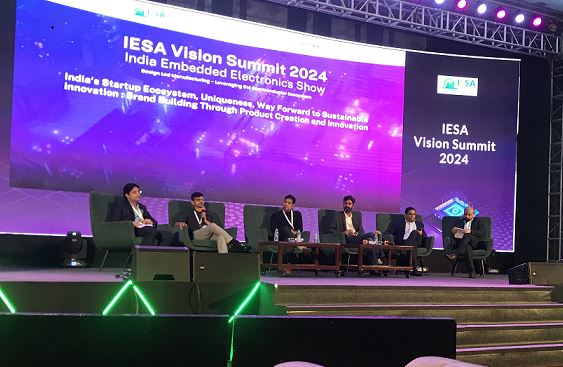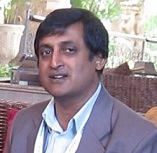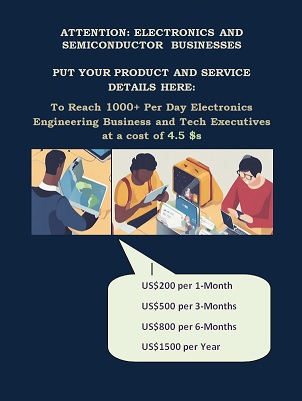IESA VS 2024: India's rising role in global electronics and semiconductor industry
Date: 01/02/2024
IESA Vision Summit 2024 held on 24th and 25th of Jan 2024 witnessed participation of global semiconductor eco partners such as semiconductor equipment companies, EDA companies, Indian emerging product and IP start-ups, government officials and academia on a single platform to discuss how they can collaborate hand-in-hand and work in partnership to make India semiconductor industry a part of global semiconductor network, where India plays a critical role as hub.
At the event, some of the India's strengths were confirmed by speakers and panelists such as India is home to 20% of VLSI design workforce of the world and nearly 70% of semiconductor chip making companies of the world have their presence in India or part of their operations outsourced to India based semiconductor services businesses. India is also growing as one of the biggest market for semiconductors with around 30+ billion US$ worth of semiconductors consumed in India in 2023, and it is one of the fastest growing market in the world. India has a dedicated mission called India semiconductor mission in establishing semiconductor manufacturing eco, where India is not working on isolating itself nor isolating any region. India is actively partnering with US, EU and Japan and other semiconductor powers enabling win-win like establishments for semiconductor manufacturing in India
It's not only central government, more or less all the states in India with industrial-growth dependent economies are complementing central government's new policies with their own policies to give best support to investors in terms of additional funding, land allocation uninterrupted and clean water-supply and electric power, and other such infrastructure facilities.
There is a significant establishment of large-scale electronic manufacturing in India, where latest smart phones are assembled in India and are also exported. Taiwan-based company called Foxconn has established huge operations in many parts of India. Foxconn's CEO Young Liu is awarded with Padma Bhushan for the year 2024, symbolizing how important this person's role in India's electronics manufacturing.
But everything is not rosy in Indian electronics design and manufacturing. Although significant Indian talent is working in advanced electronics and semiconductors design and manufacturing. There is severe dearth of manufacturers of passive electronic components and discrete semiconductor devices. These component are not high tech, they can be made starting from few millions US$ investment to not exceeding US$200 million in case of high end SIC/GaN discrete semiconductor fabs. Even the plastic moulded assemblies, adhesives, electromechanical connectors are too imported. These non-IC components constitute around 40-60% of total Bill Of Material (BOM) cost. In 1980s there were large number non-IC electronics component makers in India, where 70% of the such parts were locally available, where as now it has come down to 10-15%.
India was home to lot of small and mid-sized electronics-component traders, stockists and distributors to support Indian Small and Medium Enterprises (SMEs) designing and making electronics systems comparatively in smaller volumes for Indian market. Startup are little different from SMEs, SMEs generally offer cost advantage in terms of resource management, where as startups are driven by innovative ideas. Both need components in smaller volumes. Recently there is significant growth of global distributors present in India with many of them registering double-digit revenue growth each year, but the number and growth of small distributors are falling. Both startups and SMEs are given lesser importance, lesser-support and lesser cost-benefits by global large-size component distributors due to their purchase volumes are low in number. Someone has to figure out how supply chain can be made resilient and non-partial irrespective of size of companies.
Irrespective of presence of large number of engineering colleges all over India, there is skill shortage of work-force in some of the areas such as semiconductor packaging and precision electronics manufacturing. Since job opportunities are globalised, the expert-talents in India move out of India, if they get higher compensation and better opportunities off-shore. As India is producing higher and higher quantity of talent, top cream of the talent is getting absorbed by global companies. To rise both quantity and quality of human-resources in India, rising the average value of education performance is important. The best way out is to measure the average value of different performance metrics rather than highlighting star performers and Institutes. Let the college/institute's performance be measured based on average salary package in campus hiring for freshers and also measure domain specific hiring such as percentage of electronics-engineering graduates entering the core field.

Pic above: This was the most intersting panel at the event, where the panelists discussed on opportunities and challenges faced by the Indian product companies with the Title "India's Startup Ecosystem, Uniqueness, Way Forward to Sustainable innovation or ESDM Startups: Brand Building Through Product Creation and Innovation"
Sitting L to R: Nishit Gupta Scientist E, Meity, Neel Gala, CTO/Co-Founder, InCore Semiconductors, Goutam Singh, Founder & CEO FermionIC Design, Uttam Singhal, EVP & MD – Canada Operations, Signoff Semiconductors, Anil Kempanna, CEO,Cientra, and Subodh Sachan, STPI.
Here are the other recent stories on India Semiconductor from IESA Vision Summit 2024:
India Electronics and Semiconductor roundup via IESA vision Summit 2024: Cheetahs are bred
IESA VS 2024: Roads are laid and paved well leading to India semiconductor fab

Author: Srinivasa Reddy N




